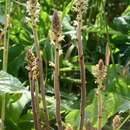Biology
(
anglais
)
fourni par Arkive
Thistle broomrape is a parasite of the roots of thistle, particularly of creeping thistle, Cirsium arvense and seems to prefer small, young host plants (2). It is a perennial species (lives for more than one year) but can also occur as an annual or a biennial, depending on the situation (2). It first appears in July and produces many small seeds, which have good powers of dispersal and seem able to remain dormant for a number of years (2).
Conservation
(
anglais
)
fourni par Arkive
Thistle broomrape receives full protection under the Wildlife and Countryside Act 1981, it is therefore illegal to cut, uproot, destroy or sell this species. As the species cannot survive in dense vegetation, disturbing the soil and opening up the sward is beneficial, and has increased the population at a few sites (2).
Description
(
anglais
)
fourni par Arkive
All broomrapes are said to resemble 'withered orchids' (3); they are parasitic, and lack the green pigment chlorophyll. Thistle broomrape is a stocky plant, and has yellow stems often with a purple tinge. The leaves are scale-like and the flowers, which have two lips, are yellowish-white or purple in colour (1).
Habitat
(
anglais
)
fourni par Arkive
Inhabits riverbanks, flood plains, road verges, and semi-natural grasslands (2).
Range
(
anglais
)
fourni par Arkive
In the UK, this species occurs only in Yorkshire in about 70 populations (2). It also occurs throughout much of Europe reaching into North Africa and western Asia. The status of the species in Britain is not clear; some authorities believe that it is a separate species to the form that occurs on the continent, and is therefore endemic to our shores (2).
Status
(
anglais
)
fourni par Arkive
Classified as Lower Risk- near threatened in Great Britain and listed on Schedule 8 of the Wildlife and Countryside Act (2).
Threats
(
anglais
)
fourni par Arkive
The most serious threat to this species is the destruction of the host plants, which are agricultural pests. Ploughing, road building, and spraying are also threats (2).

